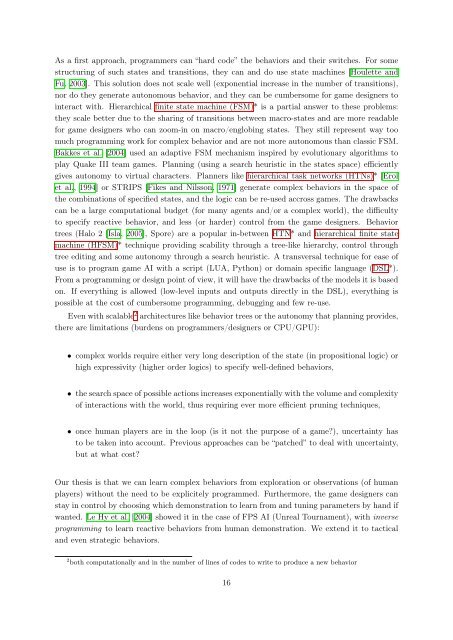Bayesian Programming and Learning for Multi-Player Video Games ...
Bayesian Programming and Learning for Multi-Player Video Games ...
Bayesian Programming and Learning for Multi-Player Video Games ...
You also want an ePaper? Increase the reach of your titles
YUMPU automatically turns print PDFs into web optimized ePapers that Google loves.
As a first approach, programmers can “hard code” the behaviors <strong>and</strong> their switches. For some<br />
structuring of such states <strong>and</strong> transitions, they can <strong>and</strong> do use state machines [Houlette <strong>and</strong><br />
Fu, 2003]. This solution does not scale well (exponential increase in the number of transitions),<br />
nor do they generate autonomous behavior, <strong>and</strong> they can be cumbersome <strong>for</strong> game designers to<br />
interact with. Hierarchical finite state machine (FSM)* is a partial answer to these problems:<br />
they scale better due to the sharing of transitions between macro-states <strong>and</strong> are more readable<br />
<strong>for</strong> game designers who can zoom-in on macro/englobing states. They still represent way too<br />
much programming work <strong>for</strong> complex behavior <strong>and</strong> are not more autonomous than classic FSM.<br />
Bakkes et al. [2004] used an adaptive FSM mechanism inspired by evolutionary algorithms to<br />
play Quake III team games. Planning (using a search heuristic in the states space) efficiently<br />
gives autonomy to virtual characters. Planners like hierarchical task networks (HTNs)* [Erol<br />
et al., 1994] or STRIPS [Fikes <strong>and</strong> Nilsson, 1971] generate complex behaviors in the space of<br />
the combinations of specified states, <strong>and</strong> the logic can be re-used accross games. The drawbacks<br />
can be a large computational budget (<strong>for</strong> many agents <strong>and</strong>/or a complex world), the difficulty<br />
to specify reactive behavior, <strong>and</strong> less (or harder) control from the game designers. Behavior<br />
trees (Halo 2 [Isla, 2005], Spore) are a popular in-between HTN* <strong>and</strong> hierarchical finite state<br />
machine (HFSM)* technique providing scability through a tree-like hierarchy, control through<br />
tree editing <strong>and</strong> some autonomy through a search heuristic. A transversal technique <strong>for</strong> ease of<br />
use is to program game AI with a script (LUA, Python) or domain specific language (DSL*).<br />
From a programming or design point of view, it will have the drawbacks of the models it is based<br />
on. If everything is allowed (low-level inputs <strong>and</strong> outputs directly in the DSL), everything is<br />
possible at the cost of cumbersome programming, debugging <strong>and</strong> few re-use.<br />
Even with scalable 2 architectures like behavior trees or the autonomy that planning provides,<br />
there are limitations (burdens on programmers/designers or CPU/GPU):<br />
• complex worlds require either very long description of the state (in propositional logic) or<br />
high expressivity (higher order logics) to specify well-defined behaviors,<br />
• the search space of possible actions increases exponentially with the volume <strong>and</strong> complexity<br />
of interactions with the world, thus requiring ever more efficient pruning techniques,<br />
• once human players are in the loop (is it not the purpose of a game?), uncertainty has<br />
to be taken into account. Previous approaches can be “patched” to deal with uncertainty,<br />
but at what cost?<br />
Our thesis is that we can learn complex behaviors from exploration or observations (of human<br />
players) without the need to be explicitely programmed. Furthermore, the game designers can<br />
stay in control by choosing which demonstration to learn from <strong>and</strong> tuning parameters by h<strong>and</strong> if<br />
wanted. Le Hy et al. [2004] showed it in the case of FPS AI (Unreal Tournament), with inverse<br />
programming to learn reactive behaviors from human demonstration. We extend it to tactical<br />
<strong>and</strong> even strategic behaviors.<br />
2 both computationally <strong>and</strong> in the number of lines of codes to write to produce a new behavior<br />
16


